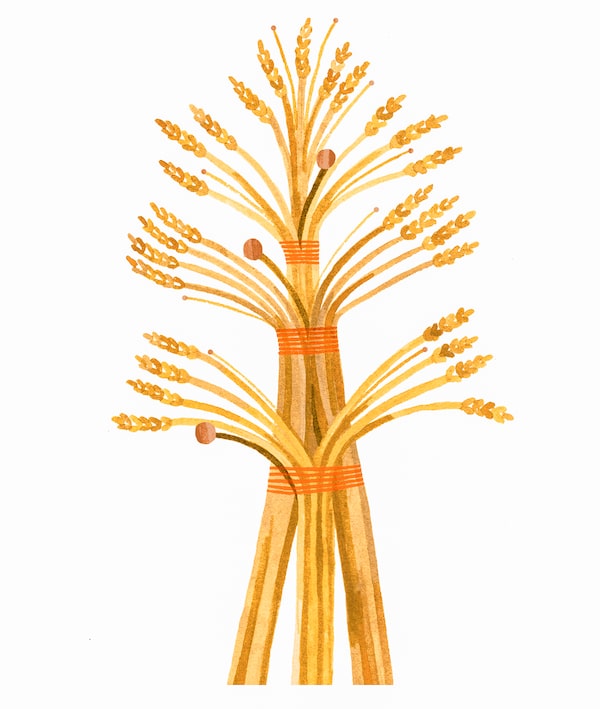First Person is a daily personal piece submitted by readers. Have a story to tell? See our guidelines at tgam.ca/essayguide.

Illustration by Mary Kirkpatrick
This year I decided to make our own didukh for Christmas. This traditional Ukrainian decoration symbolizes a good harvest and is usually made of wheat, rye or oat stalks. In English, didukh means “grandfather’s spirit” and by bringing didukh into the house on Christmas Eve, we invite our ancestors to visit us and bring their blessings. Also known as a Bread Tree, it can be made from the first or last sheaf of grain stalks preserved from the summer harvest. But my wheat arrived from Etsy.
One of my first memories of didukh comes from celebrating Christmas with my grandparents in a small village in western Ukraine. On January 6, most of our Christmas Eve was spent cooking, my grandmother moving seamlessly between the 12 traditional dishes, me helping with smaller tasks like grinding poppy seeds in a large clay bowl for kutia, the most important Christmas dish made of wheat, poppy seeds, honey, nuts and raisins. All dishes were made with the simplest ingredients (root vegetables, cabbage, beans, dried fruit and mushrooms, nuts and poppy seeds) and traced back to the garden or forest behind my grandparents’ house. Fruits and vegetables were harvested and foraged over the summer and fall and preserved for the winter. Every dish had a story to tell and spoke of hard work and connection to the land. To this day, Christmas Eve dinner is one of my favourite meals, so satisfying to make and delicious in its simplicity.
In the evening, I helped my grandmother set the table. When my grandfather brought a bale of hay inside and spread it on the floor, the smell of summer filled the small kitchen. My younger brother and cousin dove right in and hid under the table where they sat mooing, oinking and clucking, which, according to the Christmas lore, would help ensure healthy and plentiful livestock the next year. Then in came didukh – a hefty sheaf of wheat, drenched in spring showers and summer sunshine, tied with a red ribbon. My grandfather placed it in the corner and we sat down to dinner.
When I moved to Canada with my family almost 20 years ago, we brought a lot of traditions with us. We still make 12 dishes for our Christmas Eve dinner, even if some of the more time-consuming ones, such as sauerkraut-filled pierogies and holubtsi (cabbage rolls with buckwheat and mushrooms) come premade from a Ukrainian store. Embroidered table runners, brought over from Ukraine, decorate our buffet. We’d often pick up some straw and hay from a farm outside Toronto – not nearly enough to cover the floor but sufficient to spread on the table. And we always make sure to set an extra plate and utensils for our departed relatives. I hadn’t yet, however, managed to make didukh.
This year, I made sure to plan ahead. I ordered dried wheat on Etsy a month before and got to work researching the didukh traditions. I learned of the different ways to make it: from a simple sheaf just like my grandparents had in their house to elaborate trees decorated with ribbons, dried flowers and berries. I started by separating wheat stalks into bunches of seven, which symbolize seven generations, seven days of the week and seven colours in the rainbow. I then put these bunches together, layer after layer, tied them with ribbons and added dried calendula flowers from my balcony garden until slowly a Bread Tree emerged. The final step is furnishing it with three “legs” to stand on. These are the roots, our connection to the past and to the land. The top of the Bread Tree is heavy with seeds that hold the promise of next year’s harvest and looks ahead to the future.
As I made our didukh, I thought of its journey to our table – a journey more complicated than my grandparents’ Bread Tree ever had to make. I thought of the hands that dropped seeds in the ground, tended to the sprouts, harvested wheat stalks, dried them, packaged them, shipped and delivered to our doorstep. I pondered my connection to the land across the ocean, the land that nurtured and shaped me, but also of what this connection means here, in this new country, on Indigenous land where I now live as a settler.
As I worked on the didukh, I called on all my grandparents, my great grandparents and generations of ancestors before them to bring their stories. Some of these narratives have become part of the family lore, others have been lost to the grind of time and migration, yet all of them have intertwined to bring me and my family here. I envisioned sitting down to our Christmas Eve dinner – didukh sitting proudly to one side of me, my husband and two sons to the other. And I asked myself: Am I being a good ancestor? How can I be a better steward and protector of the lands and waters near and far? What stories will I add to the tapestry of this entangled life?
Once the holidays are over, we will bring didukh with us on one of our trips to the woods and burn it. According to tradition, this releases our ancestors’ souls back into the spiritual realm and also calls for the end of winter and the beginning of spring. We will preserve the seeds though – and once spring comes, we will sow them in our container garden. The wheat for next year’s didukh will come from our balcony, raised and nurtured by our own hands and not delivered by FedEx.
Oleksandra Budna lives in Toronto.
Sign up for the weekly Parenting & Relationships newsletter for news and advice to help you be a better parent, partner, friend, family member or colleague.